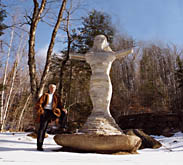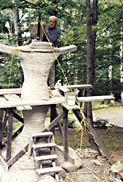Harry Rosen, dentist and artist
Harry Rosen, dentist and artist McGill University
User Tools (skip):
Harry Rosen, dentist and artist
A famous Zen koan asks, "When the many is reduced to one, to what is the one reduced?" Being in the presence of the work of Dr. Harry Rosen is like finding yourself surrounded by a koan come to life. How else to figure out the manner in which the 75-year-old professor emeritus of dentistry is able to single-handedly create a nine-foot-tall rock sculpture made up of close to 400 rocks and topped off with a 1,000-pound stone for its head? Begin to peel away the layers of meaning that make up a Zen koan, and you are on your way to understanding the focus and single-mindedness that comprise the work and imagination of Rosen.

Professor emeritus of Dentistry Harry Rosen and some of his Earth Art
A specialist in prosthodontics (a branch of dentistry that addresses structural problems in the mouth), Rosen has a lifetime of accolades. In 1996, he was presented with the Award of Excellence by the American Academy of Opera-tive Dentistry. He travels the globe as a guest lecturer, an international diplomat for the McGill Faculty of Dentistry and the branch of the MUHC multidisciplinary residency program he currently directs.
Rosen's inward journeys, however, have provided him with some of his most rewarding results. "Once I get involved with a project, be it work or play, a certain creativity takes over within me," says Rosen. "It almost hypnotizes me." While in his 30s, Rosen wanted to create a hospitable swimming environment at his lakeside vacation home in the Laurentians. He began clearing rocks from the shore and repositioning them as a lakefront wall. This sparked a life-long love affair with the art of rock building. Over the years, Rosen has also built an amphitheatre wall, a Stonehenge-like rock garden and now his latest project, a series of immense figures modelled after the human form. Utilizing a system of hand-held pulleys and levers, a winch and chains, a tripod and an I-beam, he is able to move stones up to 5 tons in weight.
"Inukshuk Welcoming Sculp-ture 1998" and "Universal Woman on a Half Shell" are Rosen's latest creations. Describing what he creates as "Earth Art, since it enhances the contours of the earth," a piece can take in excess of three years to complete. However, Rosen credits his ability to truly exist in the moment as the critical factor allowing him to successfully realize these projects. "We are all taught that tasks can be broken down into stages," explains Rosen. "What we are not taught is to completely ignore the stages other than the one we are involved with. Once I am in step 1, steps 2, 3, 4 and 5 do not exist for me anymore. That has always been my natural strength, and that is exactly what I teach my students."
Like a high performance athlete entering "the zone" during competition, Rosen also speaks of accessing a sacred space. "The whole idea of pumping a winch for eight hours and seeing a rock roll 10 or 12 inches every hour is for me very much a Zen experience. The beauty of this process is that after a while you feel as though you have become an extension of the winch. You really don't feel your body." Once the activity stops, however, a different reality sets in. "I lie down and I feel like I have nothing left!"

What is left at the end of his process, however, is remarkable. The male figured "Inukshuk," shaped by mallet and chisel, stands nine feet high, weighs approximately 10 tons, and has a 1,000-pound volcanic stone for its head. "Universal Woman on a Half Shell" is a curvy stone figure standing 12 feet high, made up of more than 600 stones.
"I create access to the lake by clearing stones. The stones themselves prevent erosion. I can create an aesthetically beautiful composition of stone and trees while exposing the stone's most attractive surface. Plus, at the end of the day, I've had a tremendous workout." Rosen is currently preparing to start on the next figure in his series, a child holding a barbell.
For Rosen, a seamless transition exists between his work in the city and his creations by the waterfront. "In both dentistry and stone work, I am working on objects, cutting hard tissue. In dentistry, the work has to be as perfect as possible when you are cutting and fitting, otherwise bacteria can get in, which promotes decay," says Rosen. His sculpture requires a similar perfectionism, held together by the force of gravity, with mortar serving only to prevent water from seeping in.
